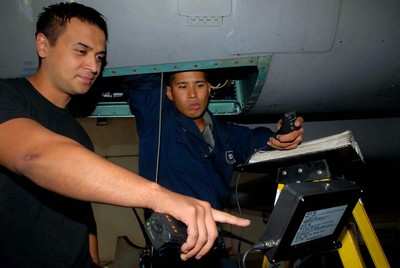Keeping The Eagles' Talons Sharp
Despite an Air Force-wide stand-down of F-15 Eagles,
pilots at Kadena Air Base in Japan are maintaining their skills and
capabilities through virtual means. Members of the 18th Operations
Support Squadron and Boeing civilian contractors with the unit have
stepped up, and provided increased time in flight simulators.

The F-15 Mission Training Centers, or flight simulators, are
recreations of the F-15 cockpit that simulate flight and combat
within the F-15, and allow 18th Wing pilots to continue to train,
even while on the ground.
"The primary sim training that we do does not differ from the
training we do day-to-day when the F-15s are flying," said Capt.
Matthew French, a pilot with the 67th Fighter Squadron. "We
normally use the simulators to augment our daily training."
The simulators are capable of recreating many of the scenarios
and challenges pilots would face while in combat and offers some
benefits that even the real thing can't match.
Kadena Air Base is one of a few installations within the Pacific
Air Forces that can link up with what's called "distributed mission
operations." The DMO links Kadena's simulators to those at other
bases, such as F-15 simulators in Alaska, or F-16 Falcon simulators
at Misawa. The simulators can also link up with Kadena's own
Airborne Warning and Control system simulators, which offer
training for E-3 Sentry pilots who usually rely on the F-15s for
their training as well.
The increase in operations tempo for the simulators places more
burdens on the 18th OSS contractors to maintain the equipment and
provide the training.
According to Maj. Michael Thomas, flight commander with the 18th
OSS, they are more than up to the challenge.
"All the contractors have leaned forward to help," said Major
Thomas. "They're all prior F-15 pilots on the Boeing side of the
house, and they know that we need their assistance for our pilots
to maintain their skills."
Despite the contractors only being obligated a specific number
of hours, they have stepped forward during this time to allow the
wing mission to continue.
"The contractors know their contract," said Robert "Rocky"
Racoma, the civilian in charge of the simulators. "But they see the
need of the government and the pilots and say 'don't worry about
it, we'll get it done.'"
"These guys will go 100-plus to ensure that these pilots get
their training," said Mr. Racoma. "And when the simulators are
having problems, they are working to fix the problems and get them
ready for the pilots."
The experience the contractors bring with them is also a major
bonus for 18th WG pilots.
"Our contractors here are prior F-15 group commanders, squadron
commanders, and old wingmen of the current pilots," said Major
Thomas. "They know each other, and know what our pilots need."

While the simulators at Kadena have allowed all the F-15 pilots
of the 18th WG to continue their training, and keep their
proficiencies in ways that wouldn't have been possible otherwise
during the stand-down, the pilots are looking forward to being in
the air again said Captain French.
"We would obviously much rather be airborne," he said. "As good
as they are, the simulators can't fully replace or replicate
actually flying the aircraft."
(Aero-News salutes Staff Sgt. Christopher A. Marasky, 18th
Wing Public Affairs)
 ANN's Daily Aero-Term (05.17.24): Very High Frequency
ANN's Daily Aero-Term (05.17.24): Very High Frequency ANN's Daily Aero-Linx (05.17.24)
ANN's Daily Aero-Linx (05.17.24) ANN FAQ: Submit a News Story!
ANN FAQ: Submit a News Story! Classic Aero-TV: ANN Visits Wings Over The Rockies Exploration Of Flight
Classic Aero-TV: ANN Visits Wings Over The Rockies Exploration Of Flight Airborne Affordable Flyers 05.16.24: PRA Runway, Wag-Aero Sold, Young Eagles
Airborne Affordable Flyers 05.16.24: PRA Runway, Wag-Aero Sold, Young Eagles




